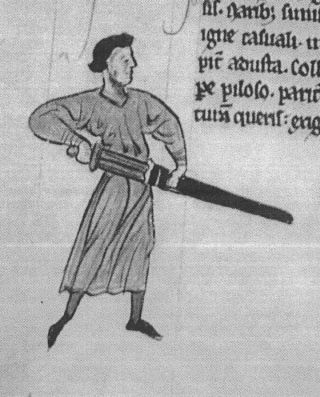Hugh de Lacy

Hugh de Lacy, Lord of Meath 1172-86
Hugh de Lacy was the fifth Baron Lacy.
The family received its name from its original seat
at Lassy in Normandy.
The principal estates of the
Lacy family were in the West Midlands of England
(Gloucestershire, Herefordshire and Shropshire)
and
along the Welsh Marches.
His contemporary, Giraldus, describes Hugh de Lacy as follows:
"... a swarthy man with small, black deep - set eyes, a flat nose, an ugly scar on his right cheek caused by a burn, a short neck and a hairy sinewy body. He was short and ill made in person, but in character firm and resolute, and of French sobriety. He was very attentive to his private affairs, and in office a most vigilant public administrator. Although much experienced in military matters, he was not fortunate as a general. After his wife's death, he fell into loose moral ways. He was very covetous, and immoderately ambitious of honour and renown."
The Norman Invasion in the 12th century changed the landscape and social organisation forever in Ireland. A predominantly rural landscape of ringforts and tuaths and pastoral farming was replaced by manors and villages with broad fields tilled in strips; castles and abbeys appeared, and walled towns sprang up everywhere.
In 1172, King Henry II of England granted the ancient Kingdom of Meath (which stretched from the Shannon to the sea) to his ally Hugh de Lacy.
Hugh de Lacy created the urban landscape of Meath with his capital at Trim, his port at Drogheda and he established urban centres like Athboy, Duleek and Navan. And he did this with incredible speed. In 1186, the Annals of Lough Cé recorded "Meath from the Shannon to the sea is full of castles and foreigners".
Under the feudal system de Lacy divided his Liberty of Meath (a quasi independent political, which had its own law courts and sherrif) among his Barons. (see link: Map of the Baronies of Meath)
He granted the area between the Blackwater and the Boyne to his ally, the knight Jocelyn de Angulo, (later Nangle) who set up the town of Navan, and who became the first Baron of Navan. (see link The Song of Dermot and the Earl).
Between 1182-86 de Lacy continued his work of castle building, consolidating his territory against the native Irish. In July 1186 however, his career and his life came to an abrupt end. While leaning over to inspect a ditch in a newly built castle at Durrow, a youth called O'Meyey, suddenly cut off his head with one blow of a battle axe which he had hidden about his person. De Lacy's head and body fell into the ditch.
De Lacy's body later was buried at Bective Abbey, with his head being interred in St. Thomas' Abbey in Dublin. A long dispute arose between the two houses for the possession of the complete remains, eventually being settled with Papal intervention in favour of St. Thomas.
Sources: Ireland under the Normans G.H. Orpen. see also: Henry II's Grant of Meath to Hugh de Lacy in 1172 - a reassessment, by Colin T. Veach, in Ríocht na Midhe, vol. XVIII, 2007
Image Hugh de Lacy from Expugnatio Hibernia by Giraldus Cambrensis NLI MS 700